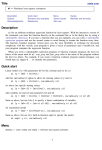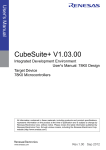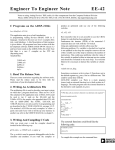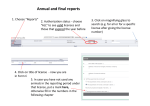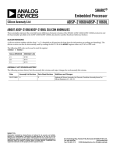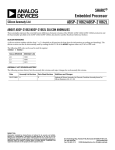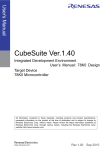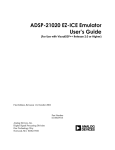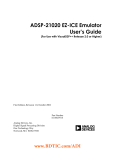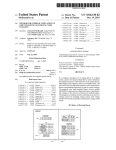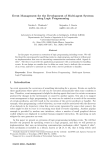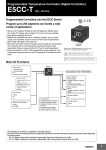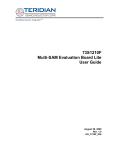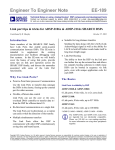Download C Interrupts - Signals and Systems
Transcript
Interrupts
C.1
C
INTRODUCTION
The C Runtime Library provides function for supporting interrupts
service routines written C. These functions install your C function as the
interrupt handler for the designated interrupt.
C.2
HARDWARE INTERRUPTS
There are two types of interrupts that are supported in the ADSP-21xxx
processors. The type used by most applications are the hardware
interrupts. These interrupts are supported in hardware on the processor.
The ADSP-21020 supports these hardware interrupts:
SIG_SOVF
SIG_TMZ0
SIG_IRQ3
SIG_IRQ2
SIG_IRQ1
SIG_IRQ0
SIG_CB7
SIG_CB15
SIG_TMZ
SIG_FIX
SIG_FLTO
SIG_FLTU
SIG_FTLI
SIG_USR0
SIG_USR1
SIG_USR2
SIG_USR3
SIG_USR4
SIG_USR5
SIG_USR6
SIG_USR7
Loop stack, status stack overflow interrupt
Timer (high priority) expired interrupt
Interrupt 3
Interrupt 2
Interrupt 1
Interrupt 0
DAG7 circular buffer overflow interrupt
DAG15 circular buffer overflow interrupt
Timer (low priority) expired interrupt
Fixed-point overflow interrupt
Floating-point overflow interrupt
Floating-point underflow interrupt
Floating-point invalid operation interrupt
User interrupt 0
User interrupt 1
User interrupt 2
User interrupt 3
User interrupt 4
User interrupt 5
User interrupt 6
User interrupt 7
C–1
C Interrupts
The ADSP-2106x SHARC supports these hardware interrupts:
SIG_SOVF
SIG_TMZ0
SIG_VIRPTI
SIG_IRQ2
SIG_IRQ1
SIG_IRQ0
SIG_SPR0I
SIG_SPR1I
SIG_SPT0I
SIG_SPT1I
SIG_LP2I
SIG_LP3I
SIG_EP0I
SIG_EP1I
SIG_EP2I
SIG_EP3I
SIG_LSRQ
SIG_CB7
SIG_CB15
SIG_TMZ
SIG_FIX
SIG_FLTO
SIG_FLTU
SIG_FLTI
SIG_USR0
SIG_USR1
SIG_USR2
SIG_USR3
Status stack or Loop stack overflow or PC stack full
Timer = 0 (high priority option)
Vector Interrupt
Interrupt 2
Interrupt 1
Interrupt 0
SPORT0 receive DMA channel
SPORT1 receive (or LBUF0) DMA channel
SPORT0 transmit DMA channel
SPORT1 transmit (or LBUF1) DMA channel
Link buffer 2 (LBUF2) DMA channel
Link buffer 3 (LBUF3) DMA channel
External Port DMA channel 0 (or LBUF4)
External Port DMA channel 1 (or LBUF5)
External Port DMA channel 2
External Port DMA channel 3
Link service request
Circular buffer 7 overflow
Circular buffer 15 overflow
Timer = 0 (low priority option)
Fixed-point overflow
Floating-point overflow exception
Floating-point underflow exception
Floating-point invalid exception
User interrupt 0
User software interrupt 1
User software interrupt 2
User software interrupt 3
The interrupts are listed in order of priority. In the C runtime
environment, the ADSP-21xxx interrupt nesting mode is on. This
means that if an interrupt service routine is in progress and a higher
priority interrupt occurs, the higher priority interrupt is serviced
immediately.
As an example, assume that your application was setup to respond to
interrupts 0 and 3. When interrupt 0 occurs, your application begins to
execute the code that you had designated as the interrupt handler for
that interrupt. When interrupt 3 occurs, the program vectors to that
handler and services interrupt 3 immediately.
C–2
Interrupts C
After the interrupt 3 service routine completes, the execution returns to
the interrupt 0 service routine. After the interrupt 0 service routine
completes, execution continues at the point the first interrupt occurred.
This example appears like this in your program:
interrupt(SIG_IRQ3, irq3handler);
interrupt(SIG_IRQ0, irq0handler);
The fixed- and floating-point exceptions are triggered by the
corresponding bits in the STKY register. It is possible that one of these
interrupts occurred during normal program operation. Be careful
when you setup a signal handler to deal with these interrupts.
C.3
ANSI C INTERRUPTS
Besides the hardware interrupts available with the ADSP-21xxx
processors, there are 6 interrupts that are required by the ANSI C
standard. They are:
SIGABRT
SIGFPE
SIGILL
SIGINT
SIGSEGV
SIGTERM
Abort signal
Floating point exception
Illegal instruction
System interrupt
Segmentation violation
Software termination signal
These signals were implemented to support the ANSI standard, they
are not supported in hardware on the ADSP-21000 family of
processors. The raise() function can invoke them, but they do not
occur independently.
You can use these interrupts in an application. They follow the same
rules as the hardware interrupts, but since they can only be invoked
with a call to the raise() function, it is much more efficient to call
the routines directly.
C–3
C Interrupts
C.4
FEATURES OF INTERRUPT SERVICE ROUTINES
An interrupt service routine (ISR) is a special routine that is executed
outside of the normal program flow. An ISR is invoked in response to
a particular interrupt occurring at an undetermined time.
Since an interrupt occurs at an unknown time, it cannot return a value
directly to a program. Thus, all ISRs are of return-type void. The void
type indicates that no value is returned from the routine. According to
the C standard, all ISRs are called with a number indicating the
interrupt that invoked them as their parameter. This tells the routine
what caused its invocation. The prototype of an interrupt service
routine is always:
void handler1(int sig);
This prototype indicates that the function handler1 accepts an
integer parameter (the signal name), and has no return value. When
you create your ISR, be sure that it has this prototype. If the prototype
is incorrect, the compiler warns you with a message similar to this one:
foo.c: In function 'main':
foo.c:10: warning: passing arg 2 of '_signal060'
from
incompatible pointer type
This warning indicates that the handler routine does not have the
correct prototype. Although your program might work even with this
warning, you should determine and correct the cause.
One way for an ISR to return information to the main program is
through the use of global variables. These variables are accessible to
both the handler and the main program. When an ISR needs to pass
information to the main program, it sets a global variable to that value.
When the main program has time to deal with the information, it reads
the global variable.
Declare these global variables as volatile . The volatile
qualifier tells the compiler that this variable can change in ways and at
times unexpected by normal program flow.
The indication that a variable is volatile causes the compiler to
treat it specially. Since a volatile variable can change outside of
the scope of normal program flow, it is not optimized away, even if it
C–4
Interrupts C
does not appear to be set anywhere.
For example, if your program has a loop that tests the state of a
variable that is never modified in the loop, the compiler thinks that it
can remove the test from the loop (since the value cannot change
within the loop).
void do_something(int param1);
int global_variable;
main()
{
global_variable = 0;
while(1)
/* Stay in this loop */
{
if( global_variable )
do_something(global_variable);
}
}
In the section of code shown, the compiler can see that
global_variable is set to zero outside of the loop and not
modified within the loop. It assumes that it can execute the test once
outside of the loop, and not need to perform it at every iteration.
In general, this is a safe assumption, and can result in a significant
performance improvement for your code. If, on the other hand,
global_variable was modified by an interrupt service routine
outside of the scope of normal program flow, this assumption is
incorrect.
The volatile qualifier tells the compiler that it cannot make any
assumptions about the variable, and that it must perform the test every
iteration of the loop.
When you write an interrupt service routine, try to spend as little time
in the ISR as possible. When an interrupt is serviced, all lower priority
interrupts are not serviced until the higher priority interrupt exits.
To reiterate, consider interrupts as exceptional situations. The less time
spent in an interrupt service routine, the better.
C–5
C Interrupts
C.5
THE DIFFERENCE BETWEEN SIGNAL() & INTERRUPT()
There are two ways to setup a routine as a handler. The first way,
which is ANSI compliant, is to use the signal() routine. The
signal() routine (as defined by the ANSI standard) setups up an
ISR to respond to one invocation of the specified interrupt. After the
ISR has responded once, the interrupt will be ignored in the future.
Using the signal() function, the only way to respond to an
interrupt more than once is to reinitialize the ISR with the signal()
function every time the ISR is executed.
Since most systems designed with the ADSP-21000 family of
processors need to respond to some interrupts continuously, Analog
Devices created an extension to the standard that sets up an ISR to
respond continuously to an interrupt. The extension is the
interrupt() routines. These routines takes the same parameters as
the signal() routine; the only difference is that an ISR that has
been setup with interrupt() responds continuously to an
interrupt, while one that is setup with signal() only responds
once.
C.6
INTERRUPT DISPATCHERS
The ADSP-21000 Family Runtime C Library provides interrupt
dispatcher routines.
The signal.h header file provides function prototypes for the
standard ANSI signal.h routines and also for several ADSP-21xxx
family extensions such as interrupt() and
clear_interrupt(). It also includes ANSI-standard signal
handling functions of the C library.
The signal handling functions process conditions (hardware signals)
that can occur during program execution. They determine the way that
your C program responds to these signals. The functions are designed
to process such signals as external interrupts and timer interrupts.
C–6
There are three interrupt dispatchers, normal, fast, and super. The
interrupt dispatchers let you disable interrupts and modify the
processor’s MODE1 register from an interrupt handler. The normal
interrupt dispatcher and fast interrupt dispatcher preserve MODE1
register writes in an interrupt handler after the interrupt is serviced,
Interrupts C
but the super interrupt dispatcher does not. The interrupt dispatchers are
described below.
Normal Interrupt Dispatcher—Saves all scratch registers and the loop
stack. Do loop and interrupt nesting is allowed because data is pushed
onto the stack. Requires approximately 125 cycles for interrupt
overhead. To access this dispatcher, use interrupt() or signal()
.
Fast Interrupt Dispatcher—Does not save the loop stack, therefore DO
loop handling is restricted to six levels (specified in hardware). If the
interrupt service routine (ISR) uses one level of nesting, your code
cannot exceed five levels. Interrupt nesting is not restricted (20 levels
available). This dispatcher does not send the interrupt number type to
the ISR as a parameter. Requires approximately 60 cycles for interrupt
overhead. To access this dispatcher, use interruptf() or
signalf().
Super Interrupt Dispatcher—Does not save the loop stack, therefore
do loop handling is restricted to six levels (specified in hardware).
Interrupt nesting is disabled. This dispatcher does not send the
interrupt number type to the ISR as a parameter. This dispatcher uses
the secondary register set. This dispatcher only works with the
ADSP-21020 (Rev. 1) and with all ADSP-2106x SHARC processors.
Requires approximately 30 cycles for interrupt overhead. To access this
dispatcher, use interrupts() or signals() .
C.7
THE IDLE() FUNCTION
If your main program waits for an interrupt to occur before doing
something, you can use the idle() function supplied in the C
Runtime Library. The idle() routine executes the IDLE function of
the ADSP-21xxx processor. The IDLE instruction causes the ADSP21xxx to wait at the IDLE instruction until an interrupt occurs. When
an interrupt occurs, the ISR is executed, and normal program flow
continues after the IDLE instruction.
C.8
THE CLEAR_INTERRUPT() FUNCTION
This function is used to clear a pending interrupt. When an interrupt
occurs, the processor latches that interrupt in the IRPTL register. The
interrupt remains latched until it is serviced or cleared. If your
application is about to setup an ISR for an interrupt, a meaningless
occurrence of that interrupt could be pending. If you do not wish to
service it, clear the interrupt before calling signal() or
interrupt().
C–7
C Interrupts
The clear_interrupt() function takes the signal name as its parameter.
C.9
THE RAISE() FUNCTION
This function is used to cause an interrupt to be invoked manually. It sets the
appropriate bit in the IRPTL register. If the interrupt is not masked, the
processor vectors to the ISR (through the dispatcher).
C.10
A SIMPLE EXAMPLE
This section provides a very simple example of how to set up an interrupt
service routine and how to interface with your main program. It uses the
techniques discussed in the preceding sections.
#include <signal.h>
/* These are function that do useful work. */
extern void do_timer_things(void);
extern void do_irq0_things(void);
/* Be sure to declare any variables reference by an ISR as volatile
*/
volatile int timer_expired;
volatile int irq0_occurred;
/* Be sure to have the correct prototype for an ISR */
void timer_handler(int signal)
{
timer_expired = 1;
}
void irq0_handler(int signal)
{
irq0_occurred = 1;
}
main()
{
/* Set timer expired to zero at the beginning */
timer_expired = 0;
irq0_occurred = 0;
/* Set up the routines to respond to interrupts */
interrupt(SIG_IRQ0, irq0_handler);
interrupt(SIG_TMZ, timer_handler);
C–8
Interrupts C
/* Set up the timer */
timer_set((unsigned int)10000, (unsigned int)10000);
timer_on();
/* Loop continuously and respond to interrupts */
while(1)
{
idle();
/* Return from this function after an interrupt */
/* If the timer has expired, clear flag and do something*/
if( timer_expired )
{
timer_expired = 0;
do_timer_things();
}
/* If irq0 has occurred, clear flag and do something*/
if( irq0_occurred )
{
irq0_occurred = 0;
do_irq0_things();
}
}
}
You can use this example as a shell for your programs that use interrupts.
There are two interrupts that we use this example. The first is irq0 , which,
in this example, is connected to a push button. When the button is depressed,
an irq0 interrupts occurs. The global variable irq0_occurred informs
the main program that this has occurred.
The second interrupt we use is the timer. In the main routine we initialize the
timer to trigger an interrupt every 10,000 cycles. This means that the
timer_handler routine is executed every 10,000 cycles.
C.11
INTERRUPT OVERHEAD
This section discuss interrupt overhead and processing. It assumes that you
have a knowledge of the internals of the ADSP-21xxx processor. If you
encounter terms that you are unfamiliar with, refer to the ADSP-21020 User’s
Manual or ADSP-2106x SHARC User’s Manual.
When an interrupt (that is not masked) occurs on the ADSP-21xxx, the
C–9
C Interrupts
processor vectors to a specific address based on the interrupt that
occurred. The runtime header ( 060_hdr.asm or 020_hdr.asm )
contains the vectors for each interrupt.
The code in the vector location executes a JUMP to the interrupt
dispatcher that is part of the runtime library. The cache update is
disabled and the global interrupt enable bit is turned off.
The cache is frozen because otherwise the ISR fills the cache. This is
inefficient, since most ISRs are short and do not contain loops. By
disabling the cache, it retains its contents. So, it still contains useful
information when it returns to the code that was interrupted.
The global interrupt enable bit is shut off temporarily. This is done so
that the dispatcher is able to maintain the C runtime stack. There are
approximately 9 cycles where interrupts are completely disabled. As
soon as the dispatcher performs stack management, interrupts are
reenabled.
The interrupt dispatcher stores all scratch registers on the C runtime
stack before calling the ISR. The dispatcher needs to save the scratch
registers because C routines expect that they can overwrite all scratch
registers without saving them. Since the interrupt occurred at an
unknown point in program execution, it is likely that these registers
have meaningful values in them.
The regular dispatcher then sets up what will happen on the next
interrupt, determines the current interrupt, and calls the ISR. This
process requires about 100 cycles.
After the ISR returns, the dispatcher restores the saved registers and
executes an RTI to return to the interrupted code. This requires about
50 cycles to complete.
In addition to the processing overhead, the regular dispatcher requires
a maximum 30 locations on the C runtime stack to store registers.
C – 10
Interrupts C
The interrupt dispatcher may be modified in future releases. Refer to
your release note to see if the timing is altered.
C.12
INTERRUPT RESTRICTIONS
There are a few extraordinary situations that might cause problems
when using interrupts. When an interrupt occurs and the chip
transfers control to the dispatcher, the return address is pushed on the
PC stack. The PC stack is a hardware stack on the processor, which is
limited to 20 locations.
The C runtime model does not use the PC stack very much, so in most
cases it is possible to nest interrupts 20 deep. It is unusual for an
application to require this many simultaneous interrupts, but it is
possible that the PC stack could overflow in such a case. If your
application only uses a few interrupts it is extremely unlikely that PC
stack limitations will ever be encountered.
Note: Some fast emulation routines are called using the PC stack.
The interrupt dispatcher is designed to support the C runtime model.
If your program has assembly routines that change the mode of the
processor, it is possible that this could cause trouble with interrupts. If
for example, you code enables the bit reverse mode of the chip, and an
interrupt occurs while bit reverse is on, and the ISR uses DAG0, this
could cause problems. (The dispatcher does not use DAG0, so you
could disable bit reversal in the ISR and re-enable it before exiting).
C – 11
C Interrupts
C – 12












